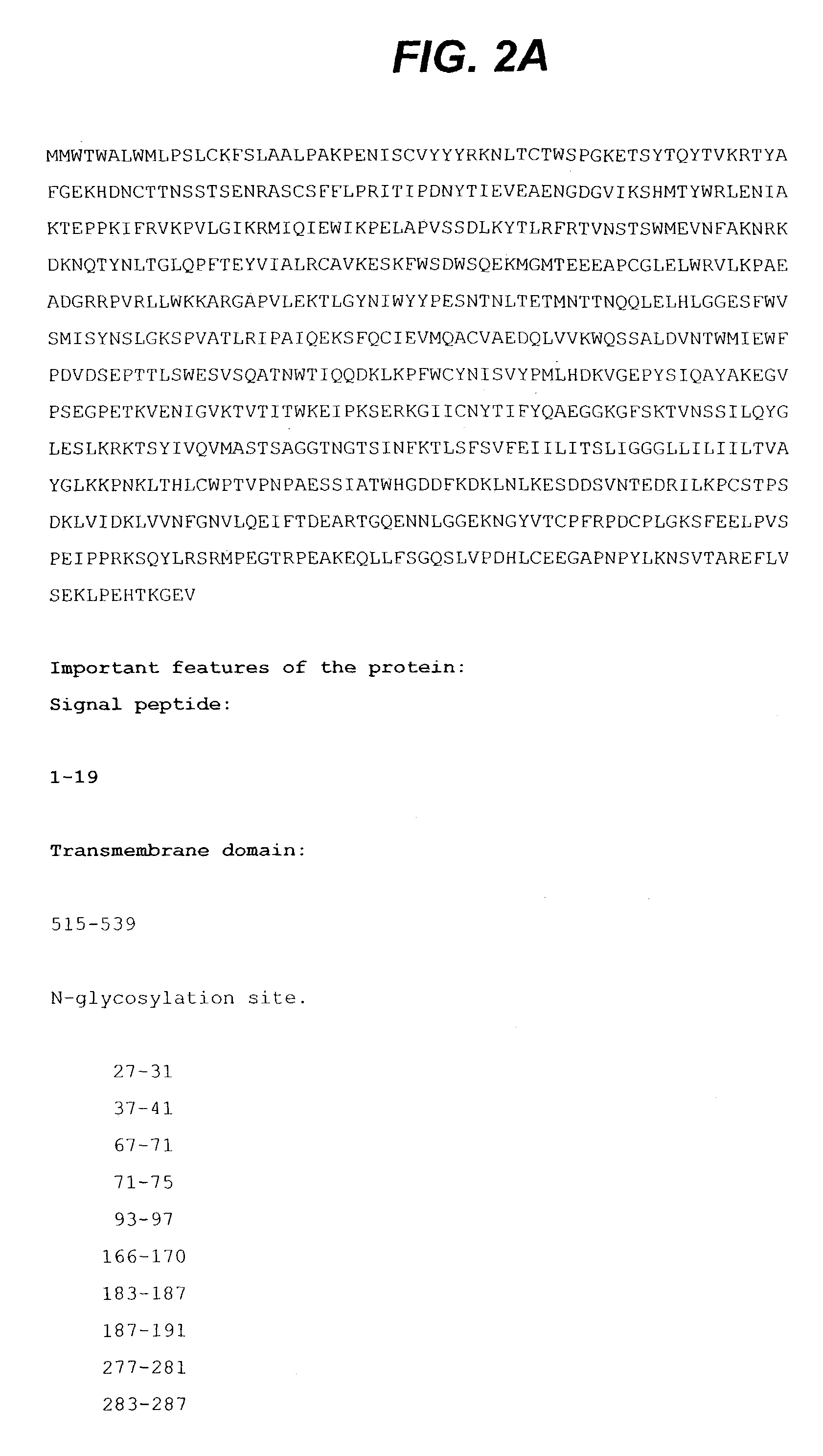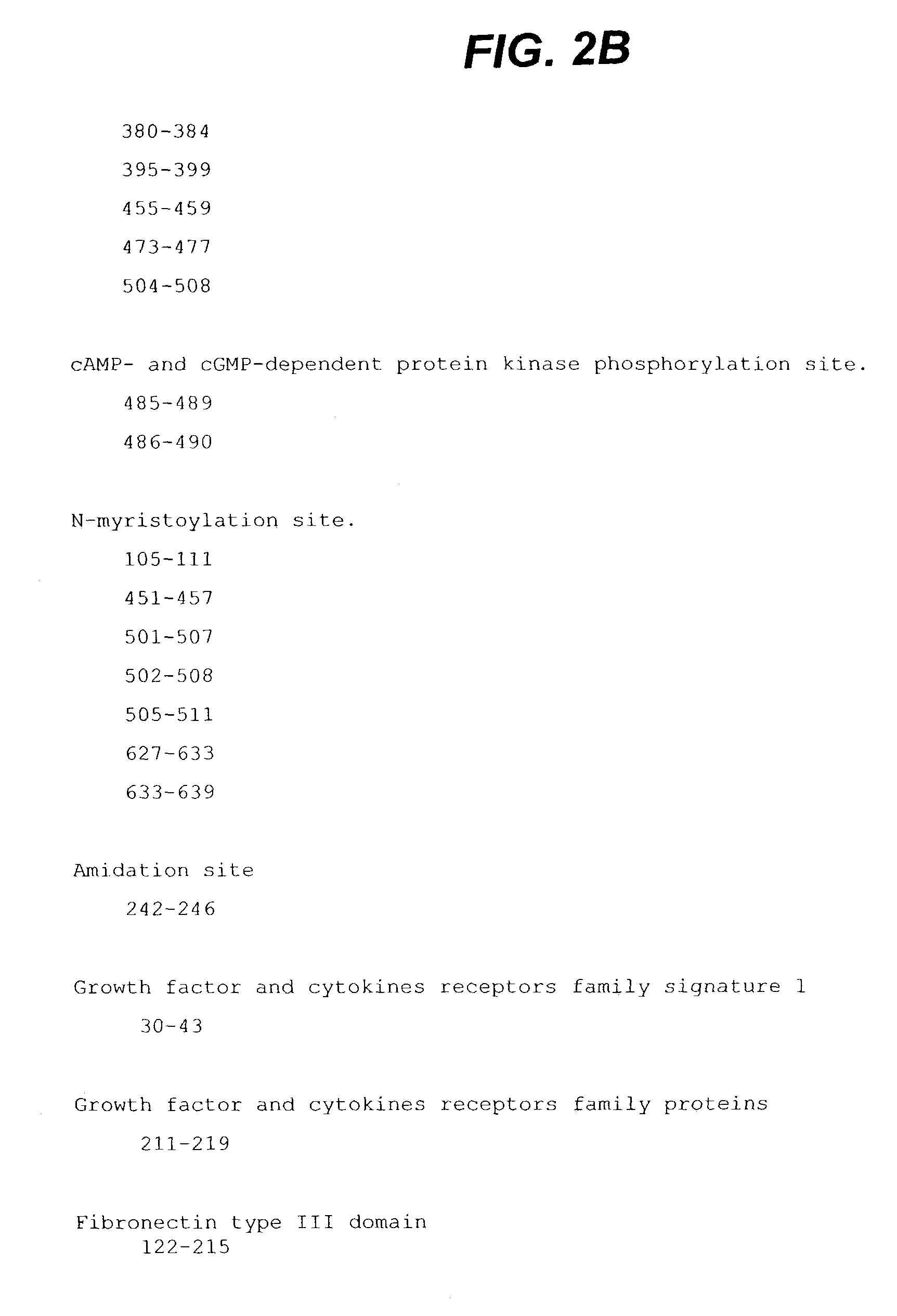Nucleic acid encoding novel type-1 cytokine receptor GLM-R
a cytokine receptor and nucleic acid technology, applied in the field of glmr genes, can solve problems such as hampered identification of novel members
- Summary
- Abstract
- Description
- Claims
- Application Information
AI Technical Summary
Problems solved by technology
Method used
Image
Examples
example 1
Isolation of GLM-R cDNAs
[0413]The extracellular domain (ECD) sequences (including the secretion signal sequence, if any) from about 950 known secreted proteins from the Swiss-Prot public database were used to search sequence databases. The databases included public databases (e.g., GenBank). In this instance, genomic DNA sequence from GenBank (i.e., AC008857) was analyzed using the gene prediction program GENSCAN, licensed from Stanford University. GENSCAN analysis predicts gene coding regions, creating sequences which can be subjected to the ECD search. The search was performed using the computer program BLAST or BLAST2 [Altschul et al., Methods in Enzymology, 266:460-480 (1996)] as a comparison of the ECD protein sequences to a 6 frame translation of the sequences. Those comparisons resulting in a BLAST score of 70 (or in some cases, 90) or greater that did not encode known proteins were clustered and assembled into consensus DNA sequences with the program “phrap” (Phil Green, Uni...
example 2
Use of GLM-R Polynucleotides as Hybridization Probes
[0420]The following method describes use of a nucleotide sequence encoding SRT as a hybridization probe.
[0421]DNA comprising the coding sequence of full-length or mature SRT is employed as a probe to screen for homologous DNAs (such as those encoding naturally-occurring variants of SRT) in human tissue cDNA libraries or human tissue genomic libraries.
[0422]Hybridization and washing of filters containing either library DNAs is performed under the following high stringency conditions. Hybridization of radiolabeled SRT-derived probe to the filters is performed in a solution of 50% formamide, 5×SSC, 0.1% SDS, 0.1% sodium pyrophosphate, 50 mM sodium phosphate, pH 6.8, 2× Denhardt's solution, and 10% dextran sulfate at 42° C. for 20 hours. Washing of the filters is performed in an aqueous solution of 0.1×SSC and 0.1% SDS at 42° C.
[0423]DNAs having a desired sequence identity with the DNA encoding full-length native sequence SRT can then ...
example 3
Expression of GLM-R in E. coli
[0424]This example illustrates preparation of an unglycosylated form of GLM-R by recombinant expression in E. coli.
[0425]The DNA sequence encoding GLM-R is initially amplified using selected PCR primers. The primers should contain restriction enzyme sites which correspond to the restriction enzyme sites on the selected expression vector. A variety of expression vectors may be employed. An example of a suitable vector is pBR322 (derived from E. coli; see Bolivar et al., Gene 2:95 (1977)) which contains genes for ampicillin and tetracycline resistance. The vector is digested with restriction enzyme and dephosphorylated. The PCR amplified sequences are then ligated into the vector. The vector will preferably include sequences which encode for an antibiotic resistance gene, a trp promoter, a polyhis leader (including the first six STII codons, polyhis sequence, and enterokinase cleavage site), the GLM-R coding region, lambda transcriptional terminator, an...
PUM
| Property | Measurement | Unit |
|---|---|---|
| temperature | aaaaa | aaaaa |
| pH | aaaaa | aaaaa |
| pH | aaaaa | aaaaa |
Abstract
Description
Claims
Application Information
 Login to View More
Login to View More - R&D
- Intellectual Property
- Life Sciences
- Materials
- Tech Scout
- Unparalleled Data Quality
- Higher Quality Content
- 60% Fewer Hallucinations
Browse by: Latest US Patents, China's latest patents, Technical Efficacy Thesaurus, Application Domain, Technology Topic, Popular Technical Reports.
© 2025 PatSnap. All rights reserved.Legal|Privacy policy|Modern Slavery Act Transparency Statement|Sitemap|About US| Contact US: help@patsnap.com



